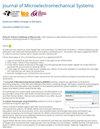机械耦合单晶硅MEMS谐振器的翻转温度点调节
IF 3.1
3区 工程技术
Q2 ENGINEERING, ELECTRICAL & ELECTRONIC
引用次数: 0
摘要
本文提出了一种调整机械耦合单晶硅(SCS)微机电系统(MEMS)谐振器频率零温度系数(翻转点)的有效方法。机械耦合MEMS谐振器是在重n型掺杂的SCS上制造的,磷掺杂浓度约为1.0\ × 10^{20}$ cm $^ - 3 $,以获得高周转点。推导了一个周转点调谐预测模型,表明机械耦合谐振器的周转点可表示为每个谐振器的有效质量与二阶TCF乘积的加权平均值及其对应的周转点。利用呼吸环(BR)模式谐振器与长伸(LE)或宽伸(WE)模式谐振器之间的机械耦合,通过调整耦合元件的尺寸,可以有意地将机械耦合谐振器的翻转点控制在工业温度范围以上。这样的翻转温度可以用于微烤箱控制的MEMS振荡器(OCMOs),以实现优异的频率稳定性。研究结果为优化MEMS谐振器的频率-温度特性提供了有价值的见解。[2024-0184]本文章由计算机程序翻译,如有差异,请以英文原文为准。
Turnover Temperature Point Adjustment in Mechanically Coupled Single-Crystal Silicon MEMS Resonators
This paper presents an effective approach for adjusting the zero temperature coefficient of frequency (turnover point) in mechanically coupled single-crystal silicon (SCS) microelectromechanical system (MEMS) resonators. The mechanically coupled MEMS resonators are fabricated on a heavily n-type doped SCS with a phosphorus doping concentration of around $1.0\times 10^{20}$ cm $^ - 3 $ for achieving high turnover points. A turnover point tuning prediction model is derived, showing that the turnover point of mechanically coupled resonators can be represented as the weighted average sum of the product of the effective mass and the second order TCF of each individual resonator, along with its corresponding turnover point. By leveraging mechanical coupling between breathing-ring (BR) mode resonators and length-extensional (LE) or width-extensional (WE) mode resonators, the turnover point of mechanically coupled resonator can be purposely manipulated to above industrial temperature ranges by adjusting the dimensions of the coupled components. Such turnover temperatures can be employed in micro-oven-controlled MEMS oscillators (OCMOs) to achieve excellent frequency stability. The results offer valuable insights into optimizing the frequency-temperature characteristic of MEMS resonators in high-end timing field.[2024-0184]
求助全文
通过发布文献求助,成功后即可免费获取论文全文。
去求助
来源期刊

Journal of Microelectromechanical Systems
工程技术-工程:电子与电气
CiteScore
6.20
自引率
7.40%
发文量
115
审稿时长
7.5 months
期刊介绍:
The topics of interest include, but are not limited to: devices ranging in size from microns to millimeters, IC-compatible fabrication techniques, other fabrication techniques, measurement of micro phenomena, theoretical results, new materials and designs, micro actuators, micro robots, micro batteries, bearings, wear, reliability, electrical interconnections, micro telemanipulation, and standards appropriate to MEMS. Application examples and application oriented devices in fluidics, optics, bio-medical engineering, etc., are also of central interest.
 求助内容:
求助内容: 应助结果提醒方式:
应助结果提醒方式:


